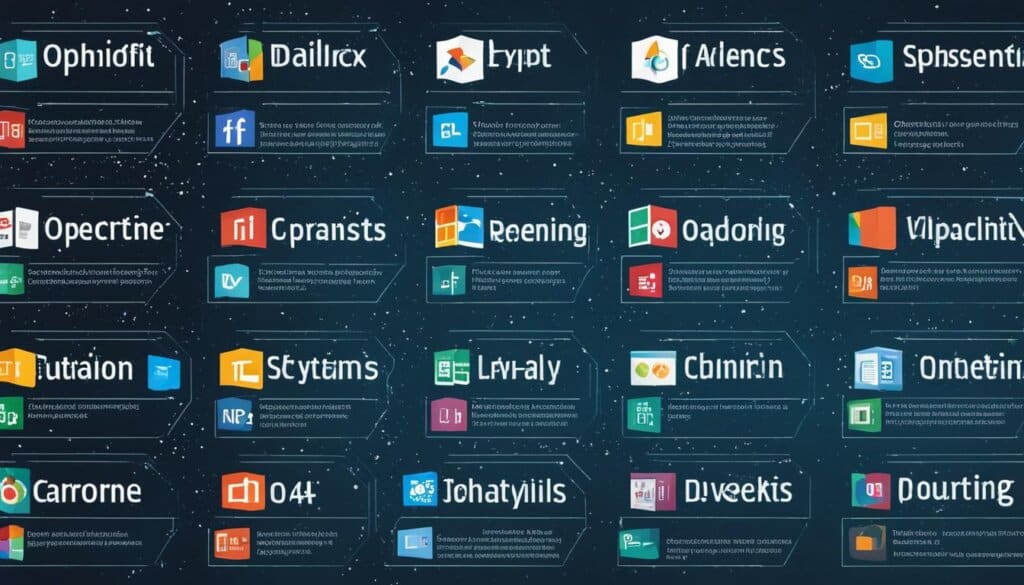Table of Contents
An operating system (OS) is the most important software that runs on a computer. It manages the computer’s memory and processes, as well as all of its software and hardware. Without an operating system, a computer is useless.
The OS acts as an interface between the user and the computer, allowing users to communicate with the computer without knowing how to speak its language. It plays a vital role in computer functionality by managing the resources such as the central processing unit (CPU), memory, and storage.
There are different types of operating systems, including Microsoft Windows, macOS, and Linux, each with its own graphical user interface (GUI) that allows users to interact with the computer through icons, buttons, and menus. Operating systems are not only used in desktop and laptop computers but also in mobile devices like phones and tablets.
They provide a common interface for applications to interact with the hardware and ensure compatibility, interoperability, security, and performance through operating system standards.
The Importance of Operating System Standards
Operating system standards play a crucial role in the functioning and development of computer systems. They are designed to ensure compatibility, interoperability, security, and performance across different operating systems and hardware platforms. Here’s why operating system standards are so important:
Promoting Compatibility and Interoperability
Operating system standards enable compatibility and interoperability among different operating systems and hardware platforms. This means that applications and services can be developed and deployed seamlessly across devices and networks, regardless of the specific operating system or hardware being used. It eliminates barriers and simplifies the sharing and exchange of data and resources, making it easier for users to work with different systems and access a wider range of software and services.
Fostering Innovation and Competition
Operating system standards provide a reference point and a challenge for operating system vendors and developers to create new features and solutions. By setting common guidelines and specifications, standards encourage innovation and competition in the industry. Vendors strive to differentiate themselves by offering unique features that enhance user experience, performance, and security while adhering to the established standards.
Enhancing Security and Reliability
Operating system standards define minimum requirements and best practices for data protection, error prevention, and failure prevention. They provide guidelines for implementing robust security measures, ensuring that operating systems can withstand potential threats and vulnerabilities. By adhering to these standards, operating system vendors and developers commit to delivering secure and reliable systems that inspire user confidence.
Furthermore, by following established standards, vendors can create interoperable security solutions that work seamlessly with other systems and hardware, making it easier for users to implement comprehensive security measures.
Performance Optimization
Operating system standards include guidelines for optimizing system performance. These standards cover various aspects, such as resource management, process scheduling, memory allocation, and disk access. By adhering to performance standards, operating system vendors and developers can ensure that their systems are efficient, responsive, and capable of handling demanding tasks and workloads.
Operating system standards are developed by industry consortia, government agencies, academic institutions, and individual vendors. They encompass various aspects of operating system design and functionality, including architecture, interfaces, protocols, formats, security, performance, and testing. By following these standards, operating system developers ensure that their systems meet the requirements for compatibility, interoperability, security, and performance, creating a better user experience and facilitating seamless interactions between different systems and devices.
| Benefits of Operating System Standards | |
|---|---|
| Compatibility | Enables applications and services to run across different systems. |
| Interoperability | Facilitates seamless communication and sharing of data and resources. |
| Security | Defines minimum requirements and best practices for protecting data. |
| Reliability | Ensures systems are robust and resistant to failures. |
| Performance | Guidelines for optimizing system speed and efficiency. |
Types of Operating Systems
In the world of computing, there are various types of operating systems designed to meet different needs. Let’s explore some of the most widely used operating systems.
1. Microsoft Windows
Microsoft Windows, developed by Microsoft, is the most popular operating system globally. It comes pre-loaded on most new PCs, making it accessible to a vast user base. Windows offers a user-friendly interface, with a familiar layout of icons, windows, and menus. Its compatibility with a wide range of software and hardware makes it a top choice for personal computers.
2. macOS
macOS, formerly known as OS X, is the operating system developed by Apple for Macintosh computers. Renowned for its sleek design and seamless integration with Apple hardware, macOS provides an intuitive and user-friendly interface. Mac users appreciate the seamless integration across devices, allowing them to effortlessly switch between their Mac, iPhone, and iPad.
3. Linux
Linux is an open-source operating system that offers a high level of customization and flexibility. It is free of cost and has numerous distributions available, such as Ubuntu, Fedora, and CentOS. Linux is widely used in the server environment due to its stability and security features. Additionally, it provides a robust platform for developers and enthusiasts to experiment and contribute to its ongoing development.
4. Mobile Operating Systems
In addition to desktop and laptop operating systems, there are also operating systems specifically designed for mobile devices like phones and tablets. Two prominent examples are:
• Apple iOS: Developed by Apple for their iPhone and iPad devices, iOS offers a seamless and secure environment for mobile users. It integrates well with other Apple devices and provides access to a vast selection of apps through the App Store.
• Google Android: Android, developed by Google, powers a wide range of mobile devices from various manufacturers. It offers flexibility, customization options, and access to the Google Play Store, where users can download apps and enhance their device’s functionality.
These mobile operating systems provide a user-friendly interface optimized for touch input and offer features tailored to enhance mobile productivity and entertainment.

Understanding the different types of operating systems is essential for choosing the right platform that suits your needs. Each operating system has its strengths and weaknesses, and selecting the one that aligns with your requirements is crucial for a seamless computing experience.
The Responsibilities of an Operating System
Operating systems play a crucial role in managing the resources and operations of a computer. They have several essential responsibilities that ensure the efficient and effective utilization of system resources and provide a secure and reliable computing environment.
Process Management
One of the key responsibilities of an operating system is process management. This involves handling the execution of tasks or processes, including creating, starting, pausing, resuming, and terminating processes. The operating system also manages the allocation of CPU time and memory resources to different processes, ensuring that each process gets the necessary resources to function properly.
Memory Management
Memory management is another crucial task performed by an operating system. It involves allocating and managing memory for processes. The operating system ensures that each process has enough memory to execute its tasks. Techniques like virtual memory are used to utilize the hard disk as additional memory when the physical memory is limited. By efficiently managing memory, the operating system maximizes the overall performance of the system.
File Management
File management is responsible for how the operating system handles files and directories. This includes organizing, maintaining, and protecting files, as well as performing file operations such as reading, writing, and deleting. The operating system provides a file system that allows users to store and retrieve data in an organized manner. It ensures data integrity and security by implementing access control mechanisms and enforcing file permissions.
“Operating systems are like air traffic controllers for computers. They manage the flow of processes, allocate resources, and ensure that everything runs smoothly.”
By effectively managing processes, memory, and files, the operating system ensures that the computer functions properly and that users can perform their tasks efficiently. It maintains system stability, prevents resource conflicts, and provides a seamless user experience.
The responsibilities of an operating system are crucial for the overall performance and functionality of a computer system. Process management, memory management, and file management collectively ensure the smooth operation and utilization of system resources.
The Development of Operating System Standards
Operating system standards play a crucial role in ensuring compatibility, interoperability, security, and performance across different operating systems and devices. These standards are developed by various organizations, each with its own specific scope, purpose, and audience.
Industry consortia, such as the Open Group, are responsible for creating and maintaining standards for specific industries or domains. They collaborate with stakeholders to define guidelines and best practices that address the unique requirements of their respective sectors.
Government agencies, like the National Institute of Standards and Technology (NIST), regulate and enforce standards at a national or regional level. They establish frameworks and protocols to ensure the safety, security, and efficacy of operating systems used in critical infrastructure and public services.
Academic institutions, such as the Institute of Electrical and Electronics Engineers (IEEE), contribute to the development of operating system standards through research and innovation. They explore new technologies, propose novel approaches, and foster collaboration among experts in the field.
Individual vendors, like Microsoft, take ownership of defining and implementing standards for their products or services. These vendors play a vital role in driving innovation and advancing the capabilities of operating systems through their expertise and industry leadership.
Operating system standards cover various aspects, including architecture, interfaces, protocols, formats, security, performance, and testing. They provide a common ground for developers, users, and stakeholders to achieve seamless integration, efficient resource utilization, and reliable system performance.
“The development of operating system standards involves a collective effort from industry consortia, government agencies, academic institutions, and individual vendors. Together, they shape the future of operating systems and pave the way for a more connected and secure digital world.
| Organization Type | Examples |
|---|---|
| Industry Consortia | The Open Group |
| Government Agencies | National Institute of Standards and Technology (NIST) |
| Academic Institutions | Institute of Electrical and Electronics Engineers (IEEE) |
| Individual Vendors | Microsoft |
Learning and Applying Operating System Standards
For individuals interested in learning about operating system standards, there are various sources and methods available. Official documents such as specifications, manuals, guides, and tutorials can be accessed through the websites of the organizations that develop the standards or online repositories. Online courses offered by platforms like Coursera, Udemy, or edX provide comprehensive instruction on operating system standards. Blogs and podcasts discussing and analyzing operating system standards are also valuable resources. Joining communities and forums dedicated to operating system standards allows people to connect with others who share their interest or involvement.
Applying operating system standards involves using compatible hardware and software, developing applications and services that adhere to the standards, and adopting practices and policies aligned with them. Standard-based guidelines, recommendations, benchmarks, audits, evaluations, and certifications can be utilized to design, optimize, and measure operating system compliance and performance.
The Benefits of Learning Operating System Standards
By learning operating system standards, individuals can gain a deeper understanding of the principles and best practices that govern the design and functionality of operating systems. This knowledge equips them with the skills to create efficient and reliable applications, ensure compatibility and interoperability with different operating systems and devices, and enhance system security and performance.
Learning operating system standards is a valuable investment for developers, IT professionals, and technology enthusiasts who want to stay updated with the latest industry trends and deliver high-quality solutions.
Applying Operating System Standards in Practice
Applying operating system standards involves several key steps:
- Ensure the use of compatible hardware and software that adhere to the specified standards.
- Develop applications and services following the guidelines and requirements set by the operating system standards.
- Adopt practices and policies that align with the operating system standards, such as secure coding practices and data protection measures.
By adhering to operating system standards, developers can create solutions that are reliable, secure, and compatible, ensuring seamless integration with other software and hardware.
Best Practices for Applying Operating System Standards
- Regularly update skills and knowledge through continuous learning, such as attending seminars, workshops, or online courses.
- Participate in forums and communities dedicated to operating system standards to stay updated with the latest developments and share experiences with other professionals.
- Follow industry best practices and guidelines when developing applications and services.
- Conduct periodic audits and evaluations to ensure compliance with operating system standards and identify areas for improvement.
- Obtain certifications or qualifications related to operating system standards to demonstrate expertise and credibility.
By implementing these best practices, individuals can effectively apply operating system standards and contribute to the development of robust and interoperable systems.
The Future of Operating Systems
The future of operating systems is poised to embrace a new era of potential, driven by the rapid advancement of emerging technologies. The integration of artificial intelligence (AI) and machine learning into operating systems is revolutionizing the way we interact with technology, empowering us with advanced features and capabilities.
AI engineering is at the forefront of this transformation, focusing on building comprehensive and structured operating systems that harness the power of AI across the entire system. Additionally, startup AI engineering is adapting operating systems to meet the unique needs and objectives of individual projects, further expanding the possibilities.
Both approaches to AI engineering require the seamless integration of machine learning and data analysis, enabling operating systems to process and interpret vast amounts of information, learn from patterns, and make intelligent decisions. As technology continues to advance, operating systems will evolve to incorporate new features, enhance security and performance, and facilitate greater integration with AI and other cutting-edge technologies.
The development and adoption of operating system standards will play a critical role in shaping the future of operating systems. These standards ensure compatibility, interoperability, security, and performance, allowing for a cohesive and efficient technological ecosystem. By adhering to these standards, operating systems can pave the way for a future where technology works seamlessly together, unlocking endless possibilities for productivity, innovation, and growth.
FAQ
What is an operating system?
An operating system (OS) is the most important software that runs on a computer. It manages the computer’s memory and processes, as well as all of its software and hardware. Without an operating system, a computer is useless.
What is the role of an operating system?
The OS acts as an interface between the user and the computer, allowing users to communicate with the computer without knowing how to speak its language. It plays a vital role in computer functionality by managing resources such as the central processing unit (CPU), memory, and storage.
What are some examples of operating systems?
Some commonly used operating systems for personal computers are Microsoft Windows, macOS (previously known as OS X), and Linux. For mobile devices, examples include Apple iOS and Google Android.
What are the responsibilities of an operating system?
The responsibilities of an operating system include process management, memory management, and file management. It ensures the efficient utilization of system resources and provides a secure and reliable computing environment.
Who develops operating system standards?
Operating system standards are developed by various organizations, including industry consortia, government agencies, academic institutions, and individual vendors.
How can I learn about operating system standards?
There are various sources available, including official documents, online courses, blogs, podcasts, and communities dedicated to operating system standards.
What is the future of operating systems?
The future of operating systems holds new possibilities driven by emerging technologies such as artificial intelligence (AI) and machine learning. These technologies will continue to shape the evolution of operating systems, incorporating new features and enhancing security and performance.







